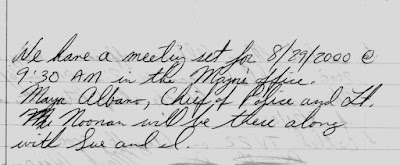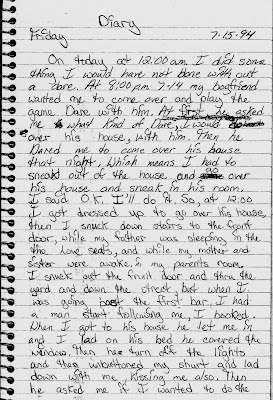Perhaps it is only fitting that my writing resurgence on the Tammy Lynds murder that started in 2023 had begun—and now ends—with a post about her friend and sometime lover Ricky Stebbins, because has been a tour de force in trying to unravel this mystery. Eager to find out what happened to her, he also wants to finally clear up decades-old rumors that he was involved with her 1994 death. What better way for him to do that than persuade a blogger to write about the murder, get people talking, and possibly uncover the true killer in the process?
But, of course, resolving a cold case rarely works that way—bloggers can shed some light on these homicides, but I don’t think any of them have ever solved one. (Let me know if I’m wrong—but doubt it.)
Ricky certainly got things moving. He facilitated my first contact with Tammy’s father, Richard, which led to me publishing her dad’s extensive files on the murder, including Tammy’s diary and the autopsy report, along his wife’s meticulous notes about what she had learned from talking to Tammy’s friends. Ricky also introduced me to several of the few friends of Tammy who cared enough to talk about the case.
“This is it” was the title of the email he sent me on July 8, 2023, when Richard first responded to one of Ricky’s comments on the Hell’s Acres Facebook page. It was the online exchange we were waiting for because we knew it would prompt Richard to either furnish the blog with information or tell me to mind my own business. Fortunately, it led to Richard’s cooperation, even though Ricky and Richard didn’t get along—fueled in part by Richard giving him dirty looks and staring him down in a bar in 2010 and then sending a warning not to “cross his path ever again” in 2019.
It was fascinating because the rumor mill had long linked Ricky and Richard to the murder—Ricky because he was “seeing” Tammy, and Richard because his polygraph was inconclusive. And both were still leery of one another nearly 30 years later—Richard had his suspicions of Ricky, and Ricky believing that Richard was hiding something.
The problem was that Ricky can be his own worst enemy at times. His damn-the-torpedoes approach to getting information sometimes worked but sometimes scared people away.
“Something has got to come from all this,” said to me in July of 2023 about Richard finally responding on Facebook. “People are right about me being too close and wanting Richard to be the killer. But if he’s not, then we’ve still got him on our side.” Richard ended up trusting me, at Ricky’s urging, and he enabled me to write about the murder in depth. It hasn’t led to much progress in the case, but we now know a lot of the details, circumstances, and who the major players are.
Ricky also related stories about Tammy, making her a three-dimensional character—a REAL person—which is tough to do in the true crime genre, especially about someone who has been dead for more than three decades and whose sister Allison is the only member of Tammy’s immediate surviving family taking an active role in trying to find out what happened. “There was more to Tammy than what happened to her,” said Ricky.
I had told Ricky that I was surprised that Allison told Springfield Republican Investigations Editor Greta Jochem that to this day he remains a possible suspect in her opinion because police had good reason to question him at the time. “In my book, he’s still on the suspect list,” she said. But Ricky wasn’t fazed, even though he was cleared by police in 1994. Indeed, he likes the fact that her feistiness means she’s still fighting the good fight. “I honestly respect Allison more for that,” he said. “Maybe it will get people to speak about the stories they heard about me.” After all, he reasoned, maybe the origin of such rumors can be traced to someone who has a vested interest in deflecting blame from themselves. “Allison was 10 at the time of the murder, so there’s no point in me ever arguing with her,” he continued. “Going back and forth with Richard was different. I was hoping he’d explain to me why he thought what he did or who told him what. Allison wouldn’t know any of this for sure—it’s all second-hand information.”
I know Ricky can be irritating at times, but he means well and I consider him a friend. What bothers some of my readers are his persistent questions and his constant clamoring that they be answered. “A lot of these perceived demands to answer questions are a result of my excitement,” he once explained to readers in a blog comment. “I’ve been talking to anyone who will listen about Tammy’s case and tell them about all these new blog posts that keep getting written. I’m easily excitable as it is, so people can imagine how I felt when every month there’s a new blog and new information. Of course I run to anyone who is still willing to listen to me and I bombard them with my thoughts, my questions and my comparisons to past posts and comments.”
Are you exasperated with Ricky? Then I guess you can blame me. “I’ve annoyed a lot of people in my quest for answers, but my persistence has paid off each time, so it has encouraged me to continue,” he wrote. ”I was beyond nervous writing Hell’s Acres about Tammy. She’s always been one of those subjects I’d rather not talk about in public, because people still add my name to the list of murder suspects—plus there was/is a lot going on in my life and Tammy’s case comes with a different type of stress. Thankfully I kept pushing forward, albeit slow at times. After reading all Hell’s Acres blogs, I honestly thought he could help or point me in the right direction. I really appreciate the fact that he took everything I said seriously and took the time to write about it. Richard Lynds was impressed enough by his writing to share his file on Tammy.”
* * * * * * *
Last April, when Ricky had a Tammy Lynds flag made to hang near the spot where she was found, I thought it was a good—although unorthodox—opportunity to publicize the cold case by reminding longtime residents of the slaying and prompting Google searches from people who have no idea who she is. It surely could have more impact that tacking a bunch of flyers to telephone poles.
Ricky modified the Batman insignia on the flag into a question mark. “I think Tammy would have appreciated this,” he said. Both of them watched Batman: The Animated Series on Fox network every Sunday night at 7:00—same bat time, same bat channel.
On April 4, when he went down there at night to scout out a place to hang the flag, it was peaceful. He could hear frogs in the distance. Then he heard a rustling noise that seemed much larger than a squirrel or a bird—someone jumped out of the woods. “I kill faggot-ass white people!” the stranger yelled. “What are you doing in my woods? What the fuck you doing in my woods?” He charged across the street at Ricky, who backpedaled. “I got a knife and I’m gonna kill your faggot ass! I’ve shot motherfuckers.” He had dark skin, dark clothing, and was bobbing and weaving and ready to brawl. Ricky tried to get his bike in between them, but the man shoved it to the ground.
“I have a knife too,” said Ricky, and he pulled it out. “Get the fuck away!” he continued. I’ll stab you!” But the man kept walking forward, lunging, swinging, and screaming: “I’m in a gang! I kill faggot ass white people!” Ricky dialed 911, but the guy wasn’t impressed. “I don’t give a fuck about no cops! You don’t know me! You’re gonna die, faggot-ass motherfucker!”
Then the man said he had a gun and pulled out an object, but it was too dark to tell what it was. “He pointed something at my eyes with a laser on the top of it while threatening to shoot me,” said Ricky, who turned his body to the side while stepping away, hoping to make a smaller target, and turned his head so any light wouldn’t blind him. “Those seconds felt like minutes,” he said. “I kept yelling stop.”
“Fuck this,” thought Ricky. “I’m not ready to die.” He stepped forward and went at the man. “It was like he was moving in slow motion and I closed the distance,” recalled Ricky. “I went to stab him in the neck. We locked eyes.”
* * * * * * *
The irony of possibly getting killed at the very place where his friend was murdered 31 years ago—and while he looking for a place to hang a memorial/reminder at the spot—was not lost on Ricky. For decades, homeless people have been—and still are—camping in those woods, raising the possibility that one of them could have accosted Tammy. So, who was this psycho, and what ended up happening in this confrontation?
That answer, my friends, you’ll have to find out in the next blog post. When I started writing Part 30, I thought this was a logical final post—30 seemed like a good, round number to end on, and there was no new information coming in.
But Ricky has a big personality—so big that I have to split this blog post into two parts and leave you with a cliffhanger for the time being. So stay tuned for Part 31: same bat time, same bat channel.

















.png)







.png)


.png)

